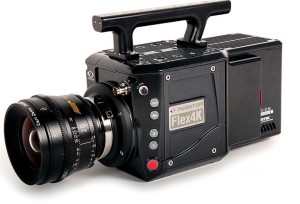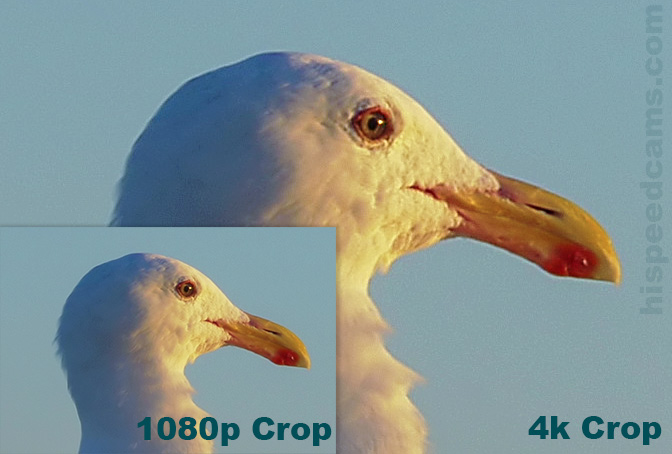With 4k TVs, projectors and computer displays entering the marketplace in droves it is only a matter of time until 4k finds it’s way into the super slow motion realm for TV, Cinema and scientific analysis.
There is a strong argument for the increased resolution when it comes to capturing at 4k in any frame rate. It gives freedom to crop or punch in for a Full HD shot and or stabilize footage with crop leeway on the borders without trashing a shot. It is also crisp in a way that can only be described as looking through a window; which is a funny analogy because when Full HD came out in the early 2000s that was used often to sell TVs and the new experience. Now we are told the real window is 4k and your perfectly functional 1080p 240Hz tv is next to useless. This is of course hardly a realistic view or currently installed TV technology.
This article by Tomsguide.com sums up the 4k vs HD and Full HD argument very well. “For a 55-inch (1.4 m) TV, If you’re not going to sit closer than 7 feet away, you’re not going to get your money’s worth.”
The human eye just can’t see the increased resolution on a TV unless the viewer is sitting close to the screen if under 55 inches. Then it becomes a re arrangement of the living room and eye strain comes into play. In order to really experience 4k on comfortable terms you will need to adopt larger TVs above 60″ Inches that can really show the experience at 7ft from the screen to the audience. Some would say that 70+ inches are the ideal for 4k content. So if your TV is 50 inches or smaller and you have a distance of 7ft or about 2.15 meters you simply will be more than ok for the foreseeable future with your current 1080p set.
The benefits of shooting in 4K by Panasonic
However if you are replacing an aging TV that was busted or no longer looks as good due to imaging components degrading over time; then a 4k TV makes sense at 40+ inches to simply future-proof your purchase and achieve better resale value. You will probably not see any increase in quality from a smaller size but since prices are starting to compete with regular full HD then it makes sense to adopt the new technology.
4k content is in it’s infancy with barely a tenth of a percent of what is available to the user in Full HD. Some would argue that most of what you get on cable is not even 1080p and they are mostly right. Compression and interlacing are creating an image that is barely 720p in many cases. If you play a Blueray disc at full 1080p HD on the TV and turn back to cable right after there is a big step down in quality. Most streaming is also heavily compressed and while it is getting better like in the case of Netflix or Amazon Instant now adopting 4k in some shows, the norm is less than ideal resolution.
Recording High Speed imaging in 4k:
Some cameras have been able to capture 1000fps at 4k for some time already. The Phantom Flex 4k announced Apr 7, 2013 has already been producing jaw dropping content. 
Phantom Flex 4k Specs:
- Full resolution 4096 x 2304
- Up to 1,000 fps at 4096 x 2160
- 2000fps at 2k
- ProRes 422 HQ codec Option NEW*
- Phantom CineMag IV recording media (1TB & 2TB)
- 32GB or 64GB or 128GB of internal memory
- Monitoring: Three main 3G HD-SDI outputs, which can be configured as independent 4:4:4 1080p signals or used together to supply a dual-link 4K output while maintaining a live HD signal
- Phantom OLED HD Viewfinder
- Lens mount: Interchangeable between PL and Nikon F/G standards – Canon EF coming soon
- 2x 12V and 2x 24V accessory outputs
- Price Above 100,000 USD
- Rental Price MSRP Daily $3500, Weekly $10,500
Phantom Flex4K Creative Painting UltraHD/4K 1000fps by info123pl
The case for 4k Slow motion gets stronger when you look at what the Phantom Flex 4k can deliver. There is a pop in detail that is not trivial here. For scientific purposes it helps determine changes in smaller features of the subject be it physical or biological. There is a hidden world that shows itself with the 2x resolution increase and 4x the pixels needed to get there.
Macaws- Phantom Flex 4K 1000fps by Chater Camera:
If the high speed camera is a microscope for time, then a high speed camera at higher resolution is also a visual microscope with the time component attached. You will see more deformation, wrinkles, force waves, bends, blows, debris than on a lower resolution high speed camera. It may be the difference between looking at a result with both eyes open or with one closed and somewhat blurry.
Hypnotic Ink Physics in 4K Slow Motion – by The Slow Mo Guys
If you take a look at the same content shot in 4k and 1080p slow motion it is clear that the information gathered is much more valuable. It shows the subject flaws and beauty in a visceral way that 1080p or HD just can’t cope with. It is a magical and awe inspiring thing to see physical and nature phenomena in a resolution that has never been captured before in. It gives insights and true discovery possibilities as now every subject is being filmed by technology so new that it is like sailing in uncharted waters.
The Dark Side:
Aside from the exorbitant price, that of a 3 bedroom home in many places and rental prices the price of a compact car for a couple of weeks, 4k slow motion recording is something of a distant reality for the average shooter not involved in a large budget production or funded experiment.
There is some hope in pricing however with the fps1000 Platinum 4k upgrade . For about 4.5k US you will be able to get a 4k large sensor slow motion option that will max out at 240fps at that resolution. It will of course do more frames at lower resolutions but it is a great start at a very low cost. Until it ships however there is no option that is market ready yet, however it is an encouraging development.
Low fps:
1000fps at 4k is not high enough for many uses especially scientific. 4k high speed cameras are being pushed for film, tv and sports capture most of the time. Scientific phenomena are sometimes measured in the million, billion and trillion frames a second. For a 4k camera to deliver 10,000 fps for example it would need to be a refrigerator sized machine at this time with a price tag in the millions. The trade off for resolution will not be ideal for industrial and scientific uses for years to come. See the below video for the state of the art high speed scientific imaging industry.
1 Billion/Trillion) FPS!!! “Ultra High-Speed Camera” HD by MIT Research
Lower Dynamic Range and Increased Noise:
The increase in resolution to 4k is not a free lunch even if the data rates and frame rates stayed the same. The pixels get smaller on the same area sensor and the dynamic range suffers in turn. The highest sensitivity ISO also gets diminished compared to lower resolution options, the noise increases and the amount of light needed also becomes an issue in order to keep up for quality.
Even if sensors continue to improve steadily, it will take decades for a 4k sensor to be able to go neck to neck and compete with current lower resolution global shutter sensors in the 720p range like those used in the fantastic low cost edgertronic camera. See this video for the edgertronic in low light environments.
At the same time current low resolution sensors will continue to improve in the sensitivity area which will make it even harder for the 4k case for high speed if you need good or exceptional low light performance.
Data Storage:
Recording 4k video at a decent data rate of 100Mbps or 12.5 MegaBytes/sec is already a storage problem. Now raw 4k is above 350MB/sec or a bit smaller depending on the compression used. And this is at regular 24 or 30p frame rates. If you had to extrapolate a second of footage in RAW at 1000fps you would end up with a file for a single second of 12+ Gigabytes. You will need new hard drives like you need coffee filters.
Let me know when you see Fire Phantom Flex 4k by Gregory Wilson
Capturing such immense data rates are not trivial matters and as frame rates increase the curve gets steeper. Storage improves slower than the pace of data acquisition increases, it would take a big leap in storage technology to get 4k frame rates at 1000fps and above to be feasible for the every day end user. Compression will improve with H.265 and newer codecs so data will be kept in check but the problem will not be corrected easily.
Final Thoughts:
4k resolution in high speed video is here at frame rates up to 1000fps at the moment, it is an impressive thing to witness. It is awe inspiring and a testament to engineering on the cutting edge delivering it to the masses. It is expensive, cumbersome and not all there especially for higher frame rates.
Scientists and industrial users will probably stay away from 4k in slow motion for a long time, for the vast majority of their uses 4k is overkill and a waste of money and storage space, and also limited recording time of a few seconds at these speeds.
For film makers and video professionals it becomes a very different proposition. It is the new realm of where the technology is advancing and what the audience will start to expect. 1080p slow motion will not cut it anymore for IMAX or the Cinema screen or even large 4k TVs above 65 inches. These avenues will need content shot in 4k and up and if slow motion is to be used it will be to enhance the experience and story in small instances as used often in Hollywood.
It may seem overkill but 4k is not a gimmick like 3D TVs and cinema in the past decade showed to be. You don’t need strange glasses to see it, anyone can experience it. 4k is a way of experiencing detail in a more realistic way by no longer looking at pixels or resolution limits with our eyes.
The change is starting in high speed and it is well advanced for regular video. 4k Slow motion is here to stay and the explosion of content that will go along with it will come; it will be a matter now of getting tools in a reasonable budget to embrace the revolution and not be left behind.
Thanks for reading! We’ll cover 4k high speed developments at HSC for years to come. Stay tuned!


What an amazing story. I read every word. Thanks!!
Good day and thanks!